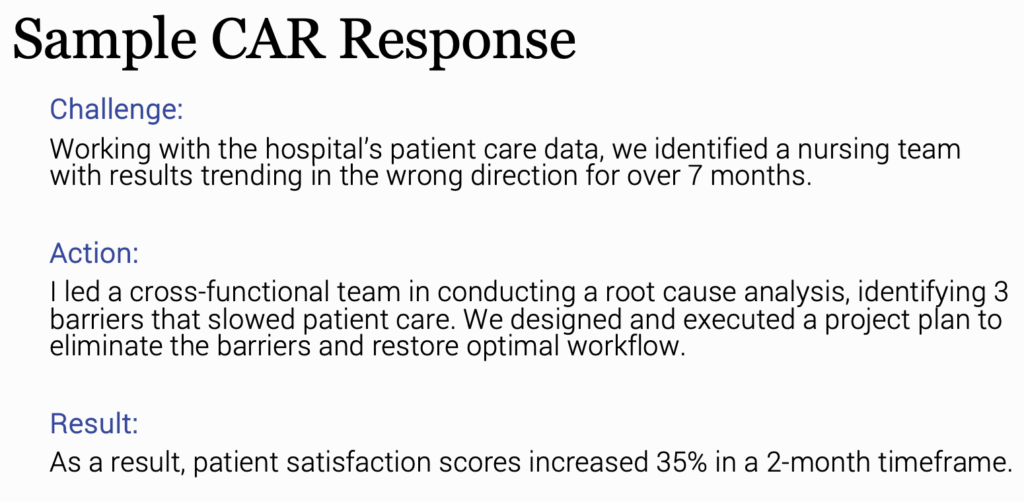So you’ve landed the most crucial step in your job search – the interview! Now what? It is time to practice, practice, practice, and become the master of these four stages of interview conversation. Understanding the breakdown of a job interview will help to ensure that you’re closing the deal and establishing yourself as the company’s top candidate.
- Connection Phase – Conversations always begin in those first few moments by assessing and enhancing the chemistry between two individuals. It’s a great idea to step in the room with confidence. We demonstrate this confidence with good eye contact and a very strong smile. And remember – you can fake it till you make it. Even if you’re completely nervous, just act like a duck! Above the water you seem totally calm and collected, even while your feet are treading like crazy under the surface.
Hopefully, in the research that you’ve done prior to your interview, you’ve identified some common points of interest between yourself and who you’re interviewing with. Whether it is a common education background, similar volunteer interests, or perhaps a shared geographic location. These examples are great points of information to bring into the conversation, and definitely better than talking about the weather.
You may choose to establish common ground with the company itself. If this is an organization you’re dying to work for – and the interviewer already works there – take a moment to bring up the fact that you’ve always been in support of the company’s mission and its role within the community.
Finally, you might also choose to establish common ground with the customers of an organization. Maybe you are a customer or client yourself, or you have a firm sense through your personal network of how the company impacts its customers. Anything that you can do to really start off that conversation showcasing that you and the individual that you’re speaking with are on the same plane can be a great start to the conversation.
- Clarification Phase – Next, we move to the clarification stage of the interview. You’ll know you have arrived here when the interviewer asks the infamous interview question, “So, tell me about yourself.”
Like it or not, it is your responsibility to clarify your skill set and show the interviewer that you have the ability to handle the primary deliverables of the job. This phase is an opportunity to make sure you are highlighting your strengths and presenting the value you can bring to an organization.
After “Tell me about yourself,” there is typically a laundry list of frequently asked questions that are used in a variety of different interviews. By using the three P’s, you can assure – even if you’re caught off guard – to give an answer that reflects your best qualities.
Be Positive. Show energy and enthusiasm in your answers.
Be Pertinent. Stay relevant to the question asked, and make sure that you are listening well and answering the question with accuracy and intention. If the interviewer requests that you share your top three strengths and you only respond with one, that is not a pertinent response.
Be Precise. That is brief, succinct and specific. Don’t spend a lot of time providing long winded answers in the clarification stage, because you’re essentially stealing time from the collaboration phase, which is where you have the greatest opportunity to bring your value forward. Remember, the clarification stage is about clarifying your skill set and your ability to handle the primary deliverables of this job. The hiring manager wants to ensure that you are the person they saw on that resume document.
- Collaboration Phase – In the collaboration phase, the interviewer is looking to determine how you will do the job and anticipate interpersonal dynamics between yourself and the other individuals within the department. It is really the most important phase in the interview process. Again, it will be critical to research the organization and the position that you’re interviewing for ahead of time in order to make this phase a successful one. At the end of the day, every position in an organization exists to help impact the company’s bottom line in a positive way. This phase is your chance to show how you will make your role in the company a success.
In the collaboration phase, you will want to demonstrate the “how” part of your future performance in this role. It is a good idea to translate your value on their terms, using the CAR technique to show how you’ve handled past situations and will perform on their team. You can use the CAR response to answer almost all behavioral questions asked in the collaboration phase.
C – Challenge. How do you handle challenges in your current role?
A – Action. What actions do you take in the face of these type of challenges?
R – Result. What was the result you were able to provide to leadership and other team members?
Most importantly, use your research and the job listing itself to prepare for this phase by understanding what exactly the company finds important and valuable for the position you are interviewing for. If the position is sales, show how you can develop relationships and close deals. If the position you’re applying for is marketing, demonstrate your creativity and results.

- Close Phase – The final phase of an interview is the Closing Phase. This is where you have an opportunity to close any gaps and reiterate your interest. The first indicator that you have reached this stage is a change in the interviewer’s body language. He or she might move papers, shift in their seat and start to talk about the next steps in the interview process. Remember, if you are not told next steps, it is your responsibility to ask for that information outright. Make sure you are clear on who and when.
Finally, end your interview by asking the 5-star question:
“What would it take for me to establish myself as your top candidate?”
It is a courageous question and immediately makes the interviewer consider how they feel about you. Their response can vary, but it is likely that the answer will illuminate any gaps still remaining to be addressed in a quick, positive statement or your follow-up correspondence.
Prepare thoroughly and practice going through these 4 stages of conversation in an interview and you will feel confident and ready! In closing, here are some suggested practice points to get you ready for your next interview:
- Develop relevant CAR stories
- Review a list of frequently asked interview questions (Google’s got you covered!)
- Establish references
- Practices closing any gaps you see between your resume and the job description


